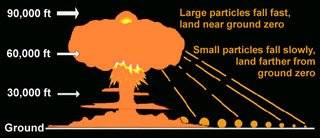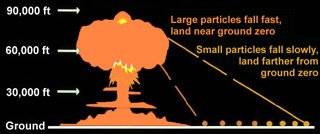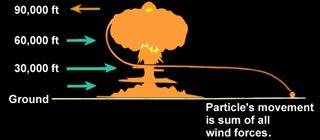 |
 |

|
Particle size: Assuming constant wind and altitude, larger particles land relatively close to ground zero and smaller particles land farther away. |

|
Altitude: The higher the initial altitude of a particle, the farther away from ground zero it lands, assuming constant wind speed and particle size. This means that the fallout pattern will be different if there is a ground burst vs. one from an altitude, and increasing altitude will also affect the fallout pattern. |

|
Wind: Wind is the most difficult factor to predict. Different altitudes through which a particle falls may have different wind speeds and directions that affect the final destination of the fallout particle. This explains how fallout can occur miles upwind of a detonation. |
Source: Armed Forces Radiobiology Research Institute's Medical Effects of Ionizing Radiation Course on CD-ROM (1999)
|



